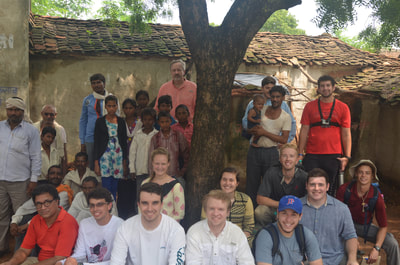Farming Village: 2nd Segment of Poverty
When people move out of tribal villages, the next step on the urban migration path is usually a farming village. Sometimes these rural communities have been in existence for hundreds of years with little change in their agricultural lifestyle. They practice subsistence farming with droughts and other environmental challenges making it difficult to break out of the cycle of poverty. There is usually a strong sense of community in these villages.
Field Visits - Summers of 2015, 2016, and 2017

For the 2015, 2016, and 2017 trips, students visited Mukarwa outside of Khajuraho.
Mukarwa is a very old village, dating back to at least the eighth century. The families live in established homes set closely along the sides of the narrow roads that wind through the village. Each family has fields nearby where they can grow vegetables, grain, and other crops. The government gives subsidies for the families below the poverty line to buy certain things. For example, a kilogram of rice can be bought for 1 Rupee (about 2 cents). Almost all of the families that students meet in the village own BPL (below the poverty line) cards and need them to afford food. The community is Sufi Muslim, a mystical branch of Islam that is very common in the region.
With each passing year, student have been able to explore more of the village. One year, students visited the local kindergarten. Other years, they have walked through the fields and beyond the historic mausoleum. Students have generally visited with one family per year.
Mukarwa is a very old village, dating back to at least the eighth century. The families live in established homes set closely along the sides of the narrow roads that wind through the village. Each family has fields nearby where they can grow vegetables, grain, and other crops. The government gives subsidies for the families below the poverty line to buy certain things. For example, a kilogram of rice can be bought for 1 Rupee (about 2 cents). Almost all of the families that students meet in the village own BPL (below the poverty line) cards and need them to afford food. The community is Sufi Muslim, a mystical branch of Islam that is very common in the region.
With each passing year, student have been able to explore more of the village. One year, students visited the local kindergarten. Other years, they have walked through the fields and beyond the historic mausoleum. Students have generally visited with one family per year.













